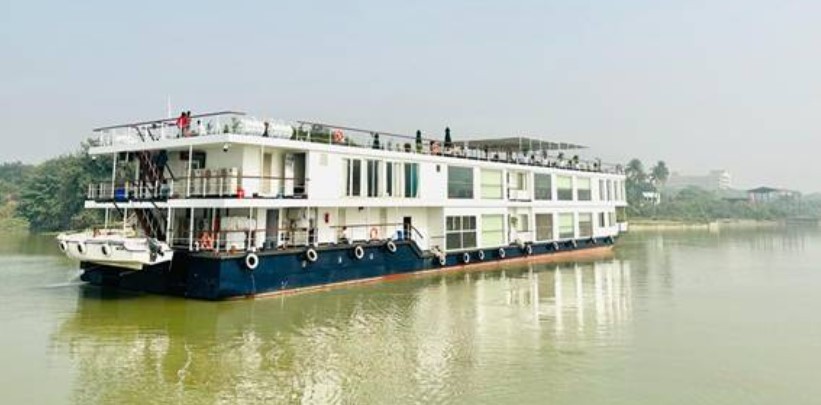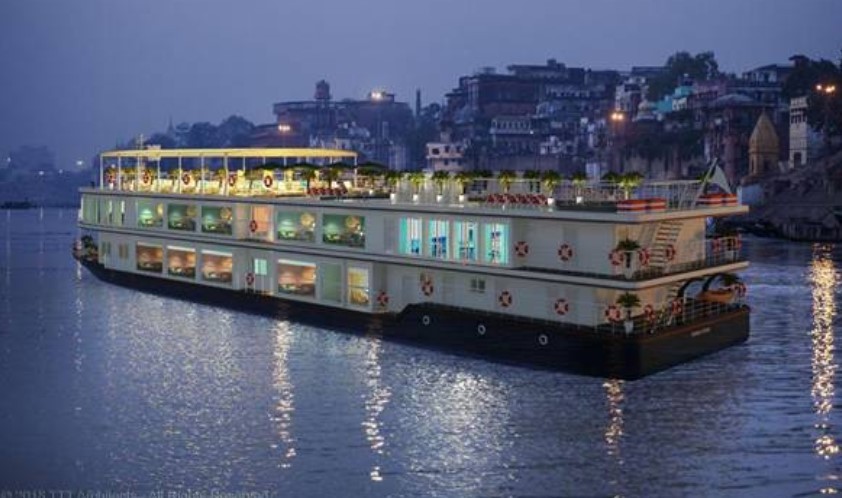Varanasi, India – The launch of the world’s longest river cruise, MV Ganga Vilas, by Prime Minister Narendra Modi on January 13th in Varanasi will bring a new era of river cruise tourism to India, according to Union Minister of Ports, Shipping & Waterways and Ayush, Shri Sarbananda Sonowal.
MV Ganga Vilas Cruise Details
The luxury cruise will cover a distance of over 3,200 km across 27 river systems in 5 states in India and Bangladesh, with planned visits to 50 tourist spots including World Heritage Sites, National Parks, and major cities.
The MV Ganga Vilas vessel is 62 meters in length and 12 meters in width, with three decks and 18 suites with a capacity for 36 tourists. The ship is equipped with pollution-free mechanisms and noise control technologies. The 51-day cruise will be the maiden voyage for 32 tourists from Switzerland, with an expected arrival in Dibrugarh on March 1st.
Economic and Employment Opportunities
Sonowal stated, “The development of this sector would generate employment opportunities, particularly for the youth, in the hinterland and coastal regions, and also boost the local economy by increasing the income of the people through direct and indirect means.” The launch of MV Ganga Vilas is expected to put India on the map for river cruise tourism and bring sustainable development to the country’s inland waterways.
Rich Heritage and Cultural Experience through MV Ganga Vilas

The itinerary of MV Ganga Vilas has been curated to showcase the rich heritage of India with stopovers at spots of historical, cultural, and religious importance. From the famous “Ganga Arti” in Varanasi, it will stop at Sarnath, a place of great reverence for Buddhism. It will also cover Mayong, known for its Tantric craft, and Majuli, the largest river island and hub of Vaishnavite culture in Assam.
The travelers will also visit the Bihar School of Yoga and Vikramshila University, allowing them to immerse themselves in the rich Indian heritage in spirituality and knowledge. The cruise will also traverse through the biodiversity-rich World Heritage Sites of Sunderbans in the Bay of Bengal delta, famous for Royal Bengal Tigers, as well as Kaziranga National Park, famous for one-horned rhinos.
The luxury cruise will cover a distance of over 3,200 km across 27 river systems in 5 states in India and Bangladesh, with planned visits to 50 tourist spots including World Heritage Sites, National Parks, and major cities.
MV Ganga Vilas Cruise to tap huge river tourism potential in India
Sonowal stated, “The MV Ganga Vilas cruise is a step towards unlocking the huge potential river tourism in the country has to offer. Our rich heritage will get further transcended in the global stage as tourists will be able to experience the spiritual, the educational, the well being, the cultural as well as the richness of the biodiversity of India.”
Sonowal added, “The development of this sector would generate employment opportunities, particularly for the youth, in the hinterland and coastal regions, and also boost the local economy by increasing the income of the people through direct and indirect means.” The launch of MV Ganga Vilas is expected to put India on the map for river cruise tourism and bring sustainable development to the country’s inland waterways.
The global River cruise market has grown at ~5% over the last few years and is expected to constitute ~37% of cruise market by 2027. Europe has been driving growth with approx. 60% share of river cruise vessels in the world. In India, 8 river cruise vessels are operational between Kolkata and Varanasi while cruise movement is also operation on National Waterways 2 (Brahmaputra).
Tourism activities like river rafting, camping, sightseeing, kayaking and so on are operation in many spots in the country. The construction of 10 passengers terminals across NW2 are going on which will further bolster the prospect of river cruise.
At present, four river cruise vessels are operational in NW2 while it is operating in limited capacity in NW3 (West Coast Canal), NW8, NW 4, NW 87, NW 97, and NW 5. As the capital expenditure is pumped to build capacity in the inland waterways, the river cruise is set to grow further with systematic forward and backward linkage for the economy, especially across the banks of the rivers.






